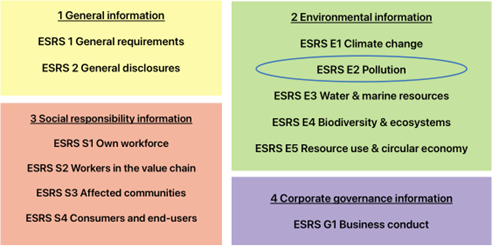This text is part of the series of brief articles that HållbarTillväxt AB has created to explain, simplify and explore the various steps that are currently most relevant in the area of sustainability; CSRD and ESRS. The ESRS consists of a total of 12 separate documents, 2 of which relate to general and comprehensive information (ESRS 1 and 2). The remaining 10, so-called topical standards, deal with various sustainability issues divided into environment, social responsibility and corporate governance – in English Environment, Social and Governance, abbreviated ESG. Fulfilment of the new requirements in CSRD and reporting according to ESRS is based on the involvement of all functions in a business, including the board and management. The board is ultimately responsible for sustainability reporting just as it is for financial reporting. Like the financial report, the sustainability report must now also be reviewed by an external auditor.

ESRS E2 – Pollution in the European Sustainability Reporting Standards (ESRS) pertains to the emissions of substances by companies throughout their operations and value chain, impacting both the environment and society. Pollution refers to the direct or indirect introduction, as a result of human activity, of pollutants into air, water or soil which may be harmful to human health and/or the environment, which may result in damage to material property, or which may impair or interfere with amenities and other legitimate uses of the environment. E2 aims to ensure that companies report on their pollutant emissions comprehensively and transparently across the entire value chain. The aim is to provide a clear picture of the environmental impact of all activities in the value chain. The increased transparency allows for the implementation of measures to mitigate the negative effects and leverage any positive opportunities. According to this standard, existing policies, measures and targets that are in place or planned to manage the company’s impact must be described. The reporting includes both direct and indirect emissions and focuses on a range of pollutants such as air pollution, water pollution, soil pollution, microplastics and substances of concern. Having a plan to replace substances of significant concern used at any point in the value chain is essential. This text will outline and explain the key components of ESRS E2.
Pollution to air, water and soil
In the reporting of pollution of air, water and soil, all substances listed in the register of emissions and transfers of pollutants in Annex 2 of Regulation (EC) No. 166/2006 of the European Parliament and of the Council must be reported on, with the exception of the greenhouse gases reported in ESRS E1 – Climate change. Air pollution includes emissions of harmful substances that affect air quality and can have significant health and environmental consequences. Some of the substances that should be reported are nitrogen oxides (NOx), ammonia (NH3), sulphur dioxide (SO2), volatile organic compounds (NMVOC) and particulate matter (PM). Water pollution refers to the release of harmful substances into aquatic environments, which can affect both ecosystems and human health. Some of the substances to be reported here are substances such as nitrogen and phosphorus, heavy metals, organic pollutants and the use of nitrates, phosphates or pesticides and other hazardous substances. Soil pollution covers the release and deposition of harmful substances on or in the ground which can lead to long-term environmental damage and affect agriculture, wildlife and human health. Here it is relevant to include inorganic pollutants, persistent organic pollutants (POPs), pesticides, nitrogen and phosphorus compounds and more.
Microplastics
Microplastics are small plastic particles, less than 5 millimetres, that have significant negative effects on the environment, especially in marine ecosystems. Microplastics come from various sources, and the most common are the breakdown of larger plastic products, packaging, wear and tear from tires and synthetic textiles. Industrial processes can also generate microplastic. Due to human consumption and production, the environment is increasingly contaminated with microplastics, found in both the oceans and our food and drinking water Once microplastics have been released into nature, they do not biodegrade. Microplastics tend to accumulate, unless they are specifically designed to biodegrade in the open environment. There is growing concern about the presence of microplastics in various parts of the environment (such as water). Microplastics have a significantly adverse impact on the environment and potentially pose risks to human health.
According to ESRS E2 guidelines, companies must now disclose information about the presence and management of microplastics in their operations and across the value chain, a new requirement for many Swedish companies. This involves identifying and measuring microplastic emissions and their sources, outlining strategies to reduce these emissions, and assessing and communicating the potential environmental impacts of microplastics. Additionally, companies are expected to provide details on the actions and technologies they are using to prevent the environmental spread of microplastics.

Photo: Tim Mossholder, Unsplash
Substances that raise concerns
Substances of Concern (SoC) are chemicals or materials that may pose risks to health and the environment. These include substances that are carcinogenic, mutagenic, toxic to reproduction (CMR), or have persistent, bioaccumulative and toxic (PBT) properties. The substances of concern, including those of very high concern (Substances of Very High Concern, SVHC), fall under the European REACH and CLP regulations.
REACH (Registration, Evaluation, Authorisation and Restriction of Chemicals): This regulation regulates and evaluates the risks of chemicals. It includes registration of substances, evaluation of risks, authorisation (permit) for the use of certain hazardous substances, and introduction of restrictions to protect human health and the environment.
CLP (Classification, Labelling and Packaging): This regulation provides guidelines for the classification, labelling and packaging of chemicals. The purpose is to ensure that hazards with chemicals are communicated clearly and uniformly to users through standardised warning symbols, warning phrases and other labelling elements
Individuals involved in these matters are advised to keep abreast of the Candidate List of Substances of Very High Concern. This list identifies chemical substances that may pose significant risks to human health and the environment, even if they are not currently restricted under REACH regulations. It serves as an early step toward stricter controls and includes substances already regulated under REACH, as well as those that may be regulated in the future. If your operations involve any substances on the Candidate List, it is wise to explore alternatives and stay informed about legislative updates.
The reporting requirements in ESRS E2 are consistent with existing laws. Companies must identify and disclose the use of hazardous substances in their products and processes in accordance with REACH and CLP regulations. Reports should include details on these substances, provide quantitative data on their use or release, and outline risk management strategies. Additionally, companies must detail their plans to replace these substances with safer alternatives and reduce their impact on health and the environment.
Gloria Gullstrand – HållbarTillväxt
© HållbarTillväxt AB 2024

